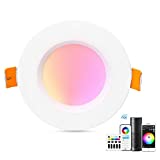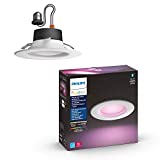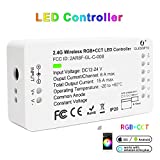I know lots of people rage against Hue for being overpriced. Maybe they are. Maybe not. Personally, I think the number of lights they’ve sold tells the real story.
My guess is that if you’re reading this, you’ve already bought into the Hue system. You probably like the responsiveness, reliability, and well-developed apps that come with it.
Maybe you’ve already built that awesome entertainment room and now you’re looking to chill out on the spending a bit. I understand. I hereby give you permission to use some of these lower cost lights instead.
Contents
Standard (E26) bulbs compatible with Hue
The standard sized base (socket) for a light bulb in the US is E26 (E27 in Europe). When you think of a regular light bulb, it’s probably an E26 base with an A19 shape. Since this is the most commonly used type of bulb, you will find the most variety of third-party options and the lowest prices.
| Image | Brand | Color | Luminosity | Price | Buy |
|---|---|---|---|---|---|
Top Top
Top
Top
Top | Innr | Color and White Spectrum | 806 lm | Buy Now | |
 Top
Top | ERIA | Color and White Spectrum | 800 lm | Buy Now | |
 Top
Top | GLEDOPTO | Color and White Spectrum | 1000 lm | Buy Now | |
 Top
Top
Top
Top
Top
Top
Top
Top
Top
Top | GLEDOPTO | Color and White Spectrum | 550 lm | Buy Now |
Compare with the following Philips Hue bulbs:
| Image | Color | Luminosity | Price | Buy |
|---|---|---|---|---|
 | Color and White Spectrum | 800 lm | Buy Now | |
 | Tunable White | 800 lm | Buy Now | |
 | White | 800 lm | Buy Now |
Recessed Downlights compatible with Hue
These recessed downlights are a popular choice for remodels. The low profile and low heat of the LEDs allow these units to fit in spaces where conventional lights wouldn’t work.
| Image | Brand | Color | Luminosity | Price | Buy |
|---|---|---|---|---|---|
 | GLEDOPTO Pro 12W 5/6 inch | White and Color Ambience | 1000 lm | Buy Now | |
 | GLEDOPTO Pro 9W 4 inch | White and Color Ambience | 800 lm | Buy Now | |
 | GLEDOPTO Pro 6W 4inch | White and Color Ambience | 500 lm | Buy Now |
| Image | Brand | Color | Luminosity | Price | Buy |
|---|---|---|---|---|---|
 Top
Top | Philips Hue 5/6 inch Recessed Downlight | White and Color Ambience | 700 lm | Buy Now | |
 Top
Top | Philips Hue 4 inch Recessed Downlight | White and Color Ambience | 650 lm | Buy Now | |
 Top
Top | Philips Hue 5/6 inch Recessed Downlight | White Ambience | 700 lm | Buy Now |
BR30 bulbs compatible with Hue
The BR30 bulbs are usually installed in a recessed fixture or in track lighting. They have a more directional light than the A19 lights above. They also require a larger heatsink because they are often installed in an enclosed space.
| Image | Brand | Color | Luminosity | Price | Buy |
|---|---|---|---|---|---|
 | Linkind | White Spectrum (2700K~6500K) | 700 lm | Buy Now | |
 Top
Top
Top
Top
Top Top
Top
Top
Top
Top | Innr | Warm White (2700K) | 806 lm | Buy Now | |
 Top
Top | ERIA | Warm White (2700K) | 800 lm | Buy Now |
Compare with the following Philips Hue bulbs:
| Image | Color | Luminosity | Price | Buy |
|---|---|---|---|---|
 | Color and White Spectrum | 650 lm | Buy Now | |
 Top
Top
Top
Top | White Spectrum | 650 lm | Buy Now | |
 Top
Top
Top
Top | Warm White (2700K) | 650 lm | Buy Now |
E12 (Candelabra) bulbs compatible with Hue
A candelabra bulb in the US is an E12 base (E14 in Europe). They’re usually used in small lamps or in chandelier fixtures. Even though they’re much smaller and generally put out less light than larger bulbs, they still cost about the same.
Imagine a chandelier with 8 different colored smart lights. For sure, it would be ridiculously expensive. But, I think some insanely cool scenes could be created.
| Image | Brand | Color | Luminosity | Price | Buy |
|---|---|---|---|---|---|
Top | GLEDOPTO | Color and White Spectrum | 200 lm | Buy Now | |
 Top
Top
Top Top
Top
Top | IKEA | Warm White (2700K) | 400 lm | Buy Now |
Compare with Philips Hue E12 bulbs:
| Image | Color | Luminosity | Price | Buy |
|---|---|---|---|---|
 | Color and White Spectrum | 450 lm | Buy Now | |
 Top
Top | Tunable White | 450 lm | Buy Now | |
 Top
Top | Warm White (2700K) | 450 lm | Buy Now |
GU10 bulbs compatible with Hue
A GU10 bulb is commonly used as a spotlight for accent lighting. A little extra color can really make those accents pop. For that reason, the option to have a color GU10 bulb seems like a no-brainer.
Nevertheless, the Hue compatible options for GU10 bulbs are relatively limited. It seems like the Philips Hue GU10 bulbs are constantly out of stock. But after a little searching, I was able to find one full color Hue compatible alternative from Gledopto.
| Image | Brand | Color | Luminosity | Price | Buy |
|---|---|---|---|---|---|
Top Top
Top | GLEDOPTO | White and Color Ambience | 300 lm | Buy Now | |
 Top
Top | IKEA Tradfri | White Ambience | 400 lm | Buy Now |
Outdoor lights compatible with Hue
If you’ve got an outdoor space you like to spend time in, adding a splash of color to the night scenes can have a magical effect.
In case you didn’t notice, Philips Hue has a whole line of outdoor lights and fixtures, too. And, just like the rest of their lights, you’ll pay a premium price to get the Hue brand. But if you’re looking to get by on the cheap, here are a few alternatives that will work with your Hue hub at a significantly lower price.
| Image | Brand | Color | Luminosity | Price | Buy |
|---|---|---|---|---|---|
 | Innr Outdoor spot light | White and Color Ambience | 230 lm | Buy Now | |
 | Innr Outdoor pedestal light | White and Color Ambience | 215 lm | Buy Now |
| Image | Brand | Color | Luminosity | Price | Buy |
|---|---|---|---|---|---|
 | Calla Outdoor bollard | White and Color Ambience | 600 lm | Buy Now | |
 | Discover Outdoor Floodlight | White and Color Ambience | 2300 lm | Buy Now | |
 | Lily Outdoor spot light | White and Color Ambience | 1050 lm | Buy Now | |
 | Econic Outdoor pedestal | White and Color Ambience | 600 lm | Buy Now | |
 | Econic Outdoor wall light | White and Color Ambience | 1150 lm | Buy Now | |
 | Appear Outdoor wall light | White and Color Ambience | 1200 lm | Buy Now |
Light Strips compatible with Hue
Light strips are a little different than the bulbs. For almost every light bulb, the controller, power supply, and light is all contained in the bulb itself. All you have to do is buy the bulb and screw it in. On the other hand, light strips are often sold in parts. In that case, it’s up to you to put the three together and make sure it all works.
The part that communicates with the Hue hub is the controller. Therefore, all you need is a controller that is compatible with Hue.
I know all you makers and DIYers (myself included) love a good LED strip. There’s so many uses and fun effects that can be created by putting lights in places where they usually aren’t.
Read More: Ultimate Guide to LED Strips
Unfortunately, the Hue strips’ price tag is as high as the rest of the Hue line (perhaps even more so).
Since us DIY types hardly have a stomach for overpriced electronics, here is a small list of strips/controllers that will work with the Hue hub:
| Image | Brand | Description | Color | Luminosity | Price | Buy |
|---|---|---|---|---|---|---|
 Top
Top
Top
Top
Top
Top
Top
Top
Top
Top
Top
Top | ERIA | Strip is 10 feet long. Includes controller, lights, and power supply. | Color and White Spectrum | 1400 | Buy Now | |
 Top
Top
Top
Top
Top
Top Top
Top
Top
Top
Top
Top | GLEDOPTO | Includes only controller (requires light strip and power supply). Uses single ID. | Color and White Spectrum | N/A | Buy Now | |
 Top
Top
Top
Top
Top
Top
Top
Top
Top
Top | GIDERWEL | Includes controller, light strip, and power supply. Uses single ID. | Color and White Spectrum | NA | Buy Now | |
 Top
Top | RGBGenie | Includes only controller (requires light strip and power supply) | Color and White Spectrum | N/A | Buy Now |
Compare those with the following Philips Hue light strips. Make sure you take into account the length of each strip.
| Image | Description | Color | Price | Buy |
|---|---|---|---|---|
 Top
Top | 80 inches, includes controller and power supply. | Color and White Spectrum | Buy Now | |
 Top
Top | 40 inch extension, no controller or power supply | Color and White Spectrum | Buy Now |
AduroSmart ERIA
I tested a pair of the ERIA color and white spectrum BR30 lights and I’ve been quite satisfied.
They are quite heavy, which is a good thing. The extra weight is most likely from a big heatsink. For an LED a big heat sink is a good thing because heat is the number one thing that causes an LED to wear out. A big heat sink helps to effectively cool the LED and ultimately lengthen its life.
The ERIA bulbs advertise a CRI of 90+. I found the colors matched well with Philips app.
Gledopto
Although the Gledopto lights will connect to Hue, they suffer from a color issue when paired to a Hue system. They seem to be calibrated differently than the Hue bulbs. Therefore, colors are always a bit off.
It would seem this problem could be fixed with the right software update. However, it is partially a hardware issue as well. The Gledopto bulbs only have the ability to display between 2700K and 6500K, whereas the Hue bulbs can display between 2200K and 6500K.
For that reason, I don’t recommend the Gledopto bulbs. I don’t feel like the cost is low enough to justify dealing with the color discrepancy. Since you are paying extra for color, you might as well pay that little extra (the ERIA bulbs) so that the color works properly.
You can buy Gledopto’s low cost lights and controllers on Amazon. Or, you can usually get them even cheaper if you buy on AliExpress. However, if you buy from there, you will probably have to wait a couple weeks for free delivery.
Innr
The UK based company sells a line of Zigbee smart bulbs that are compatible with Philips Hue. Pairing the Innr bulbs to the Hue hub was completely painless and the color quality of the lights was comparable to the Hue bulbs.
IKEA Tradfri
Do IKEA Tradfri lights work with Hue?
Yes, and they are significantly less expensive than the Hue bulbs. The white lights are a similar brightness, but the color lights are far below the Hue bulbs.
The process for getting them to work used to be somewhat annoying. They shipped with an old firmware version. In order to make them work with Hue, you had to update the firmware with a Tradfri hub.
However, that has changed. New Tradfri bulbs will ship with an updated firmware version that works with Hue out of the box.
I’ve found the best place to shop for them is directly from the IKEA website or store.
RGBGenie
RGBGenie doesn’t make any bulbs, but they do make high-quality Zigbee controllers which will connect LED strips to your Hue hub.
Related: RGBGenie Touch Panel Review
If you have a very long distance to cover with LED strips, you can save a huge amount (compared to Hue strips) by going with a custom built solution.
The Hue Plus strips have come down in price quite a bit since the early days, but they still add up pretty fast if you’re trying to encircle your room.
Which lights don’t work with Hue?
The Philips Hue bridge uses Zigbee 3.0 wireless protocol. That means anything that runs on WiFi, Z-Wave, or BlueTooth will not work.
Most smart lights are the wrong wireless protocol, so it’s fairly obvious that they won’t work. Here is a list of the ones that may be questionable:
Philips WiZ
Hey look, a Philips smart bulb! It must work with my Hue hub, right?
Nope.
I’m sure there are lots of people that bought the Philips WiZ bulbs thinking they would effortlessly pair with their Hue hub. However, the WiZ bulbs are WiFi only. The Hue hub is Zigbee only. Therefore, they are not compatible.
Osram/Sylvania Lightify/Smart+
I can confirm that Sylvania Smart lights are not compatible with the Hue hub in the US.
Apparently, they sell a different version in Europe because the Smart+ lights are compatible there. Because of that, you may read a blog post or review (probably written by someone in Europe) that states they are compatible.
But, you can trust me and iConnectHue. They are not compatible in the US.
Sengled
The Sengled bulbs do use Zigbee, but are not compatible with Hue because they use the Zigbee HA standard. However, they will connect directly to Hubitat and SmartThings or other Zigbee hubs that support ZHA.
If Philips Hue is Zigbee, why aren’t all Zigbee lights compatible?
Unlike Z-Wave, the Zigbee standard is not controlled by a central authority. Therefore, manufacturers can use Zigbee without being locked in to any sort of standard. Over time, two competing Zigbee standards emerged: Zigbee LightLink (ZLL) and Zigbee Home Automation (ZHA). Then, Zigbee 3.0 was developed to unite the two standards.
The Philips Hue hub was built on ZLL. Both ZLL and Zigbee 3.0 should work with it. But, ZHA devices will not.
Do any third-party lights work with Philips Hue Play HDMI Sync Box
Unfortunately, there are zero third-party lights compatible with Hue’s Play sync box. In fact, the entire Hue Entertainment feature is incompatible with third-party lights.
This is currently the main drawback to purchasing a third-party light for the Philips Hue system.
Final Thoughts
For me, the best third-party bulbs that work with Hue are the ERIA bulbs. They give comparable brightness and a reasonably similar color palette.
If I need a smart bulb in a location where quality doesn’t matter much, I’m going with the Cree connected bulbs. I think they’re the lowest cost smart light I’ve ever seen.
As for LED strips, I plan on installing about 150 feet of strips to go around the crown molding in my home. I’m going to use the RGBGenie controllers to hook the lights into my Hue system. I haven’t tested them yet, but I will update this post with the results.





Just want to thank you for your review. It helped me finish my lighting around my home but for less than I was expecting to pay on a short budget as well.
I’m a complete gadget geek so I have nearly got my flat as smart as I want, but I know it could get way smarter!
Excellent article Eric!
Answered every question I had on these “Smart bulbs”, how they work and what systems will work with the Hue Hub.